Goal Setting for Elementary Students
Are you a teacher looking for ways to help your students set and achieve their goals? If so, you’ve come to the right place! In this post, we’ll share some tips and tricks for goal setting for elementary students.

We have such an awesome opportunity to empower students to set goals and celebrate with them when they reach their goals. Most students don’t naturally reflect on their own learning. It’s not an innate skill that students have when they come to school. Actually, most adults don’t have that skill either. It’s something that needs to be taught.
Tips for Goal Setting for Elementary Students
When it comes to goal setting, elementary students are often very concrete in their thinking. They want to know what they need to do and how they will know when they have accomplished their goal. As a teacher, it’s important to help your students set achievable goals that foster a growth mindset.
In this post, we will discuss some tips for helping your students set and achieve goals.

Note: If you are not able to access the signup box, click here to access the free Goal Setting Forms.

Set SMART Goals with Elementary Students
So we started talking about SMART goals. We started with the concept of setting “specific” goals and made this anchor chart of the concept of SPECIFIC. We looked at the word specific in a Frayer Model and looked at some examples and non-examples. That aspect is the most powerful part of the anchor chart. I didn’t make it very “pretty”, but students got the idea of what the word specific means.
Take a look at more SMART Goal Setting Resources in this blog post.
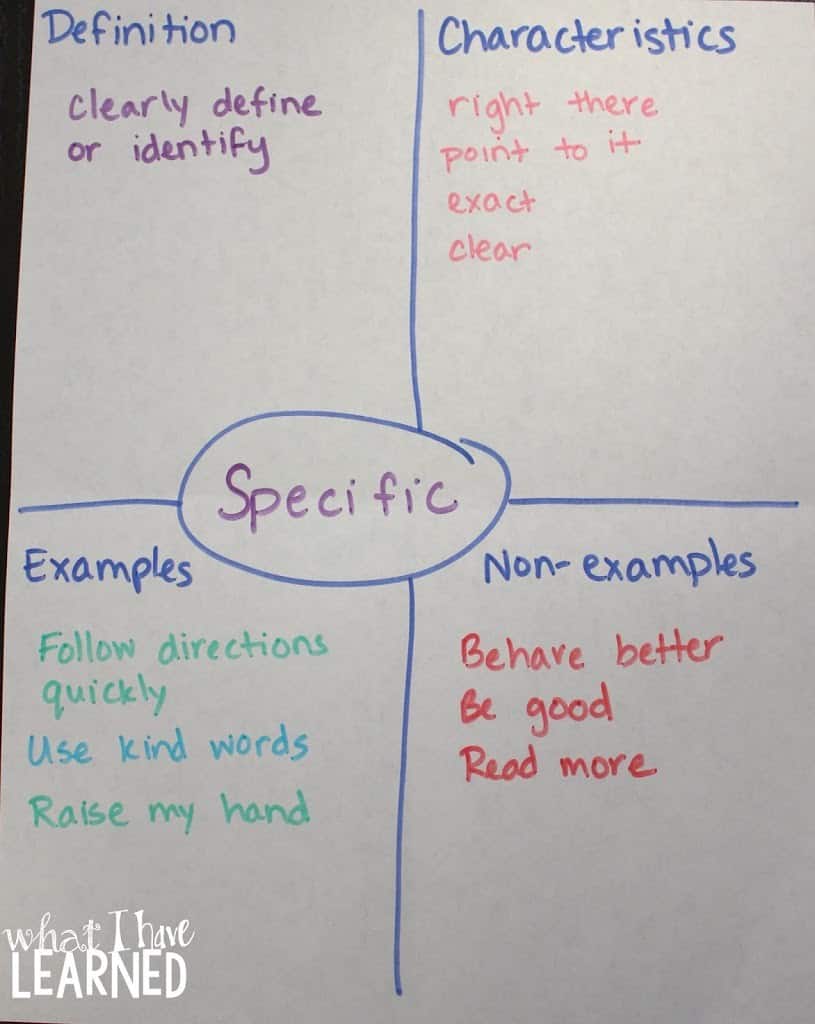
Help Students Set Specific Goals
For our first goal, I decided to focus on behavior. It is a bit more tangible than an academic goal, and students are still learning how to “be” in our classroom, so it’s the perfect opportunity to change a few things before they become a habit.
I gave students some ideas on good behavior goals. Basically, I wrote down all the things that have been annoying me, behavior-wise, for the past week. I listed them in a positive light, i.e.: what a student could do, not what they shouldn’t do.
I gave students an opportunity to look over the goals with their table groups. Each student chose one goal to work on for the next week.
I put the “Improvements” in page protector sleeves so that I can use them when I conference with a student. I can circle three or four and say something like, “I notice that you could really use some improvement on these. Which one would you like to choose to work on?” That way, there’s a choice within a structure. I can guide what a student chooses, but the student still has a choice.
I did add a couple more at the end (on the copy you see above), that aren’t necessarily annoying behaviors, but improvements that my quieter students could make. You know, those kids who just sit there, but aren’t disruptive!


Examples of Our First SMART Goal
After students determined what they wanted to work on, I had them write it down. I’m sure there’s research on this somewhere, but I’ve heard that writing down a goal means that you’re more likely to accomplish it.

In addition to the more complicated Goal Setting and Data Portfolios I have, I came up with this simple goal-setting form that I can tape down to a student’s desk and that we can collect over the course of the year.
We set to work writing down our behavior goals. Here are a few student examples.

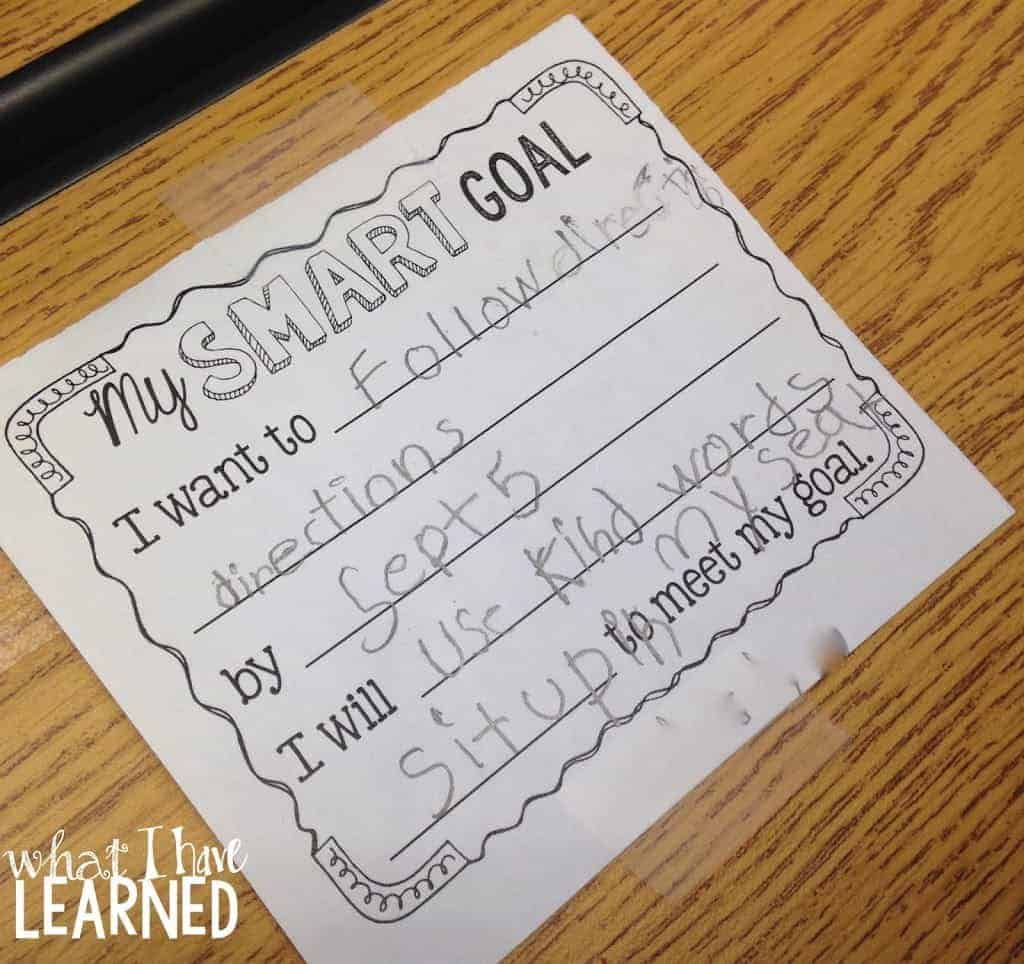
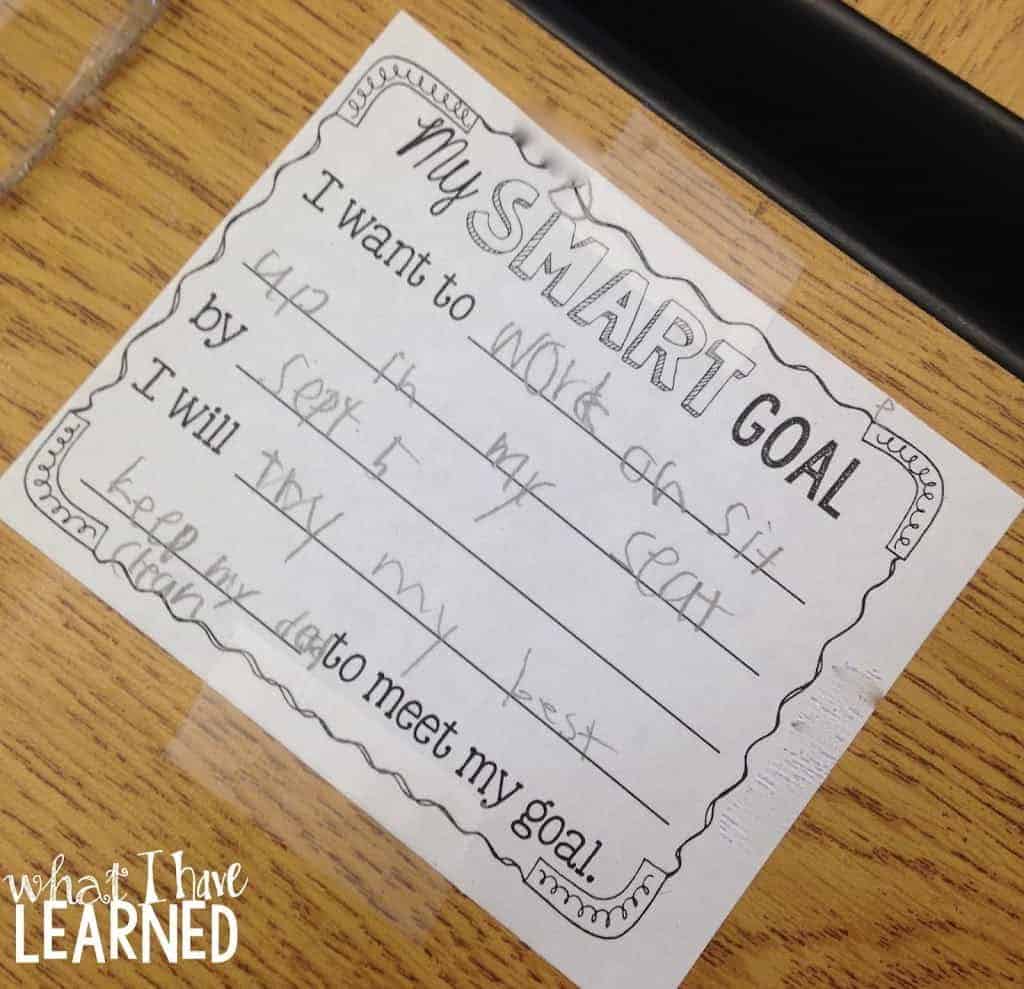


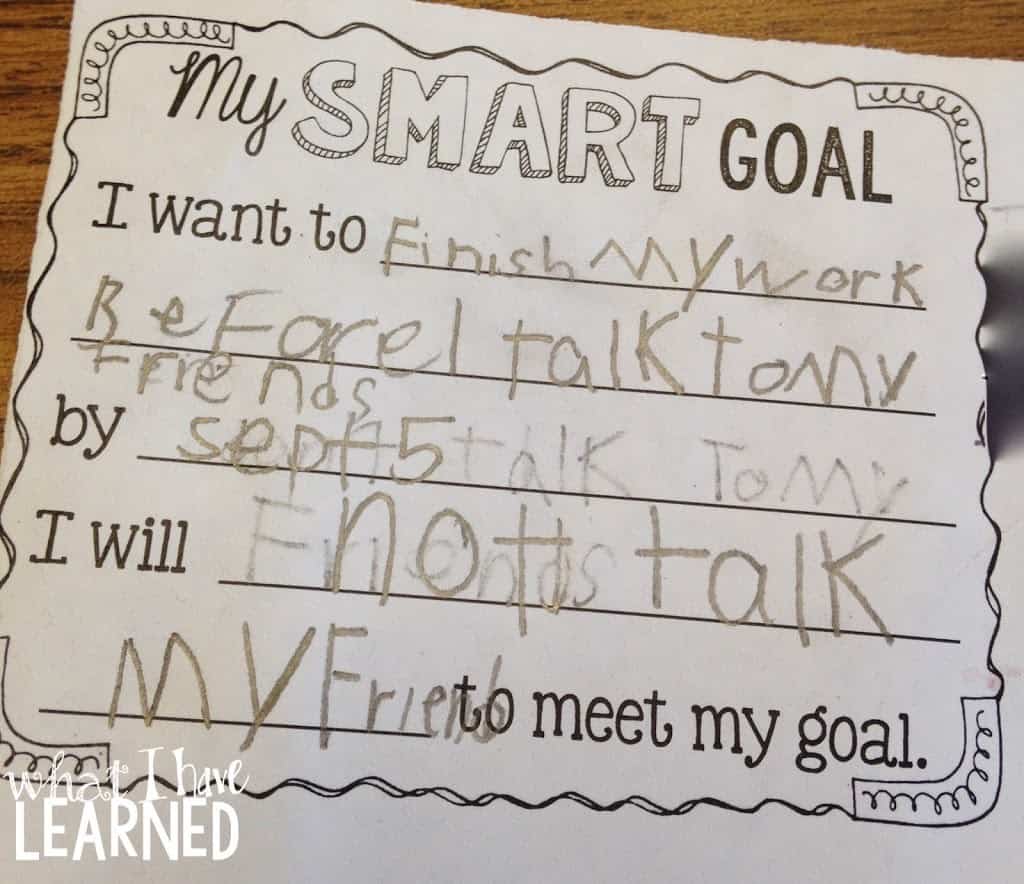
You can see that some students need a bit of work on choosing ONE goal. I also realized after we did this activity, that the “I will . . . ” part of the goal-setting form, doesn’t always lend itself well to behavior goals since most behavior goals are action in and of themselves. They don’t always require an additional action statement that tells how you’re going to accomplish the goal.
I changed up my form a bit to have a variety of options, including learning and behavior goals and a couple of different formats. Would you like a copy?

Note: If you are not able to access the signup box, click here to access the free Goal Setting Forms.

Super Improver Team
During this time, I was also implementing Whole Brain Teaching. One of the components is a Super Improver Team. Here’s our wall:
Each student has a star and for making improvements, they receive a sticker. When their star has 10 stickers they move up to the next level (blue – learner). They keep going. For every 10 stickers, they move up the levels.
The introduction of the Super Improver Team led to a discussion about how to make improvements and goals setting.
What kinds of improvements could students make? What would “count” to get a sticker? Etc.
Celebrate Students’ Accomplishments
The final part of goal setting that is very important, especially for children is the celebration! Children need to know that there’s something waiting for them when they accomplish their goal. Some people have an intrinsic motivator to set and accomplish goals. I’m one of them. But, most people don’t. The celebration is a great motivator.
As a class, we brainstormed a variety of celebrations, both big and small. Most celebrations were for our class goals, but a few of these could be for individual goals, too. The idea was to get students excited about accomplishing their goals.
Set Whole Class Goals as well as Individual Goals
SMART Goal setting isn’t just for individuals. I use to all the time to set class goals. We set behavior goals on our ScoreBoard (more positive than negative points), percentage goals on our computerized math program, number goals on how many stars we got for doing homework, etc.
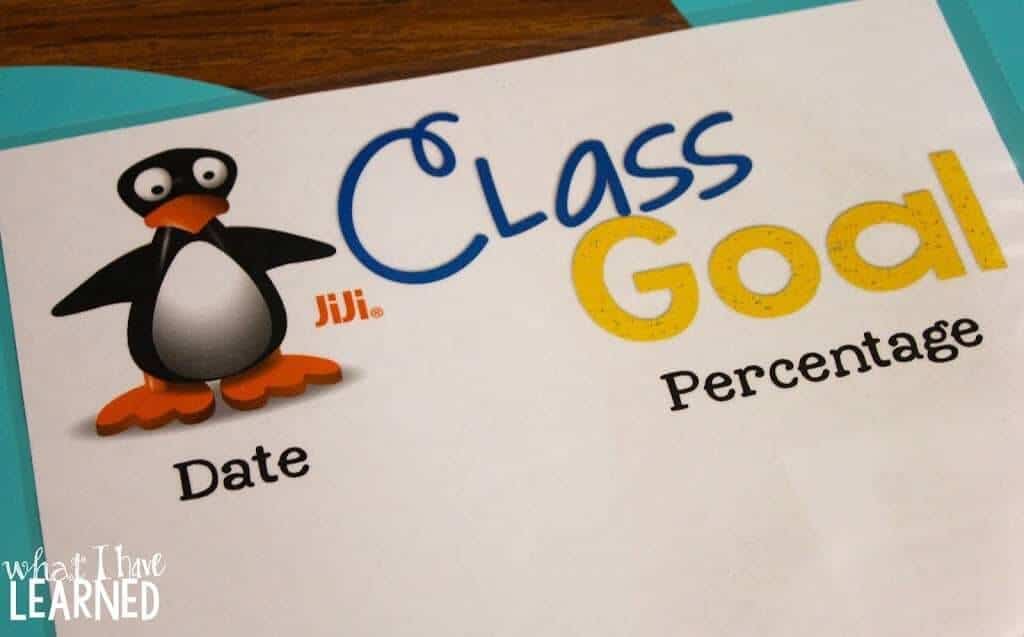
There is a myriad of possibilities for whole group goal-setting. Figure out what you want your class to do and set a goal on it.
Other Resources for Goal Setting
I’ve done a few other blog posts on Goal Setting if you’re interested in more information:
Do you set goals in your classroom, either individual or whole class? I’d love to hear how you help students see that their actions are important and make a difference in their lives.









Goal setting is the first part of our school day. Thanks for another great resource!
This is terrific. I started using whole brain teaching last Spring but not the S.I.T. I am excited to use it this year and I have been trying to figure out how to set goals for it and this is so helpful. I love the individual students writing their goals.
This is great. I too have my students set goals that they write on the Super Improver cards using suggested behavior and academic goals. But now with this handy SMART mnemonic they can write more useful and attainable goals. TeacherMsH~ThirdIstheWord
I have a question. How often do they earn stickers on their stars? Is it related to the goal on their desk? How often do you change the goal on their desk? Thanks!
Love WBT and actually am doing an internship this year with the amazing Farrah Shipley!!! I love collaborating with others using WBT so I’m definitely following you now! Check out my journey too at droppinknowledge2.blogspot.com!
Thanks for the post. Does anyone have their elementary students set academic goals? I have mixed feelings about it because of the exposure to reticule. Wondering if anyone has a work around.
I do have my second graders set academic goals, but I explain really well that the goals have to be achievable. I monitor the goals to make sure the student can do it. The goal has to be close enough to a students’ current ability. At the beginning of the year, though, I focus heavily on behavior goals so that students can experience the process of goal setting.
Hello,
What a gem I’ve found in your TPT store and your blog. I am working with a 5th grade teacher on academic goal setting and student standards based data note booking. Do you have any exemplars of the action plan for an academic area? I believe in the power of student led goal setting and data tracking. Thank you for sharing your hours of time through the templates you created and shared!
Thank you so much! This is a blog post on setting a math goal in second grade: https://whatihavelearnedteaching.com/goal-setting-learning-goals/ When I taught third through fifth grades, we’d set more academic goals than I did in second grade. In second grade, we did more behavior goals and some academic goals that aligned with practice type of things, like math facts.
Thanks for the quick reply. That post is helpful. Could you clarify the Action Plan specifically what your students write on the Action Plan, Goal-How will I know if I’m going to meet my goal?
For the action plan, they choose one activity or action that they will do to meet their goal. The how will I know is related to the goal they set and is performing on some sort of assessment. In the example in the blog post, it’s a timed math assessment.
This was a fun read because when I was in school I set the goal to be a pilot, and that was 30 years ago! after reading this I have felt an intense urge to really take to the sky! I finally signed up for lessons, I can finally live my dream! thanks for the throwback read!
Sir It’s very useful plan for students. L have planned to paste this behavior goal chart in our classroom..i am eighth grade teacher.expecting more from ypu.
This is exactly what I was looking for to help teach student’s personal goals for new classroom teachers.
Awesome!
I love these SMART goals. My students loved writing these and shared them with their parents at conferences. It is exciting to see them gain support at home.
Very informative tips thanks for sharing.
What types of goals do you use for achievement on the Super Improver board?
It varies per student. Basically, I do easy wins at the beginning and try to challenge students more as the year progresses. I want all students to feel successful and feel like they’re moving up, even if I need to focus on the small wins for them. I try to make sure that students will hit the top by the end of the year.
Types of goals include behavior and academic and really are anything that I can target and say “you did it!”.
Do you have a copy that can be purchased of you improvements I can make sheet?
I do not, sorry. I was just something I created in the moment.
Without goal setting, these young minds wouldn’t know where to go for the future. In other words, if they don’t set goals while they’re young, they won’t be motivated for anything in the future.
I would like the small SMART goal setting sheet for students but none of the links work. How can I get it? Thank you!
If you have a popup or ad blocker, it may interfere with the signup form. You can also sing up here to receive them: https://whatihavelearnedteaching.com/choose-your-own-freebie/
Great blog!!!
Thank you for sharing the SMART Goals tracking page, it will come in very handy. 🙂
Curious to know if you have a package for the levels of you Super Improver Team? That bulletin board looks fantastic and I would love to implement that system in my classroom. 😀
Thanks!
I do! You can find our more details here: https://whatihavelearnedteaching.com/monday-made-it-wbt-super-improvers-stars/
Hello! I love your “My Smart Goal” page templates! Is there a way to get them but have it say “Our Smart Goal”? So we can write a class goal together?
Thank you!
Thanks! I generally set class goals using a chart paper vs. the individual student forms. I’ll consider it on a future revision of the resource!